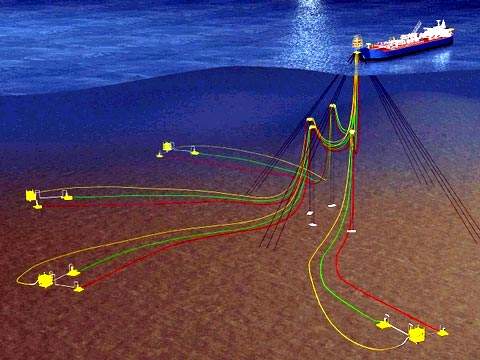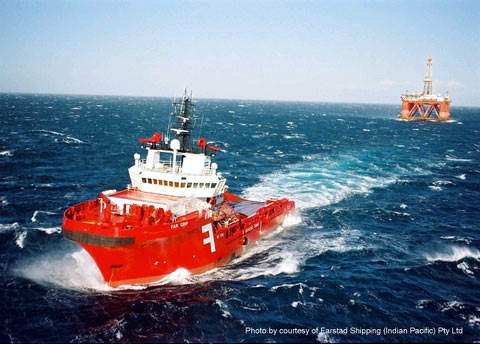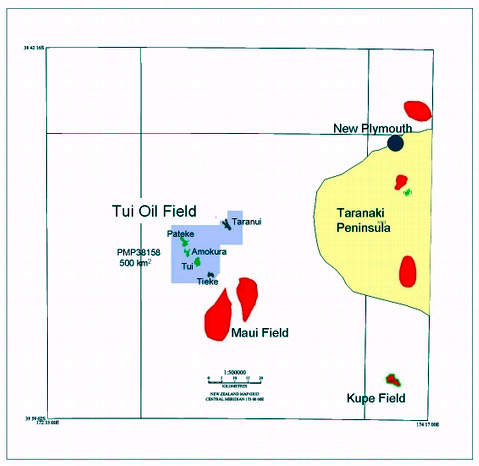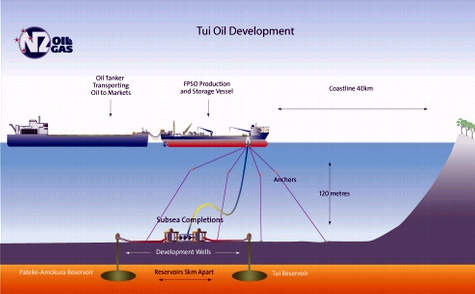Three oil fields – Tui, Amokura and Pateke reserves located in the offshore Taranaki basin, New Zealand – are being developed in phases under the Tui Area Oil Project. Work on the US$274m project began in the fourth quarter of 2005 and first oil was produced in July 2007.
The operator of the project is Australian Worldwide Exploration, which holds a 42.5% stake, and its partners are Mitsui E&P Australia Pty Ltd (35%), New Zealand Oil and Gas Ltd (12.5%) and Pan Pacific Petroleum (10%). The contract for the project was awarded to Prosafe Production Services Pty Ltd.
During 2003-04, a joint venture between AWE New Zealand Pty Ltd and New Zealand Overseas Petroleum Limited discovered the three adjoining oil fields 40km from the coastline. The Tui-1 well, drilled in February 2003, encountered a 10m oil column in excellent quality reservoir. A marine seismic survey was subsequently carried out in April 2003 to delineate the Tui field accumulation and other nearby structures.
Based on 3D seismic mapping, the partners drilled further exploration wells on nearby structures similar to the Tui field during 2004. The Amokura-1 well was drilled in April 2004, and encountered a 12m oil column. The Pateke-2 well was drilled in August 2004 and also encountered a 12m oil column.
Other prospects, including Tieke and Taranui, were identified within the Tui area on the seismic map. In 2007, however, the Tieke-1 exploration well proved unsuccessful and was suspended, while Taranui-1 encountered only minor oil and was plugged and abandoned.
The project supplies the Asia Pacific region including refineries on Australia’s east coast.
Geology
The oil accumulations are in the Kapuni-F sandstone units, deposited during the Paleocene in the ‘Kapuni’ paleogeographic shoreface fairway. The reservoir is at a depth of about 3,650m subsea.
Organic-rich shale sediments and coals of the Late Cretaceous and Paleocene are the likely sources of the oil, generated at deep depths within the Taranaki Basin ‘kitchen’ areas, such as the Kahurangi sub-basin to the west and northwest of the Tui area accumulations. The oil migrated vertically through faults and fractures and then laterally via carrier beds, finally accumulating in Paleocene sandstone reservoirs within structural trap closures.
The structural traps are low relief, dip-closed features. The reservoirs are clean, laterally extensive, high permeability marine sandstones, with the oil accumulations overlying strong aquifer drives.
The light sweet Tui Area oil is very similar to that of reservoirs at Maui field, offshore Taranaki, and Bass Strait. Though the output from the four wells is expected to dwindle gradually, the payback on the initial capital has been quite high. NZOG, for example, recouped its US$34m investment in the project in about four-and-a-half months.
Project specifications
In a reasessment of the field in June 2008, the recoverable oil reserves in the three fields were raised to 50.1 million barrels. Initial production in July 2007 was 50,000bopd and by 30 June 2008 the project had produced 14.2 million barrels of oil, against a pre-production estimate of 9 million barrels. Production for the financial year 2008-9 is expected to be about 9 million barrels.
The development consists of the four horizontally drilled and subsea completed wells, each tied back to a leased Floating Production Storage and Offtake (FPSO) vessel, the Umuroa. The extended horizontal production sections in the oil reservoirs range from 819m to 1,850m.
Due to a shortage of suitable offshore drilling rigs, a contract was awarded to Diamond Offshore for the use of the Ocean Patriot semi submersible rig.
Technical highlights of the project are said to include geosteerable drilling of the four horizontal oil production wells, a first for New Zealand; the longest horizontally drilled wells in New Zealand; subsea wellhead completions, the first of their kind in New Zealand; and modification of the Umuroa to include a swivel production turret, allowing the vessel to swivel for currents and weather while maintaining production output.
FPSO
The Umuroa has an oil storage capacity of 700,000 barrels and the has been designed to cater to different types of offtake oil tankers. The four wells are linked to the FPSO which can handle up to 120,000 barrels of oil per day.
Under Umuroa’s leasing arrangement, Prosafe is responsible for its operation for an initial period of five years. The lease contract value is US$178m for the first phase of the project, and in May 2008 an agreement was signed to extend the Umuroa’s charter to the end of 2002.











